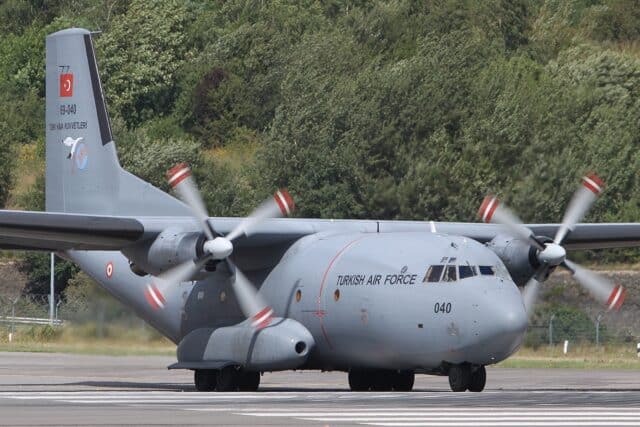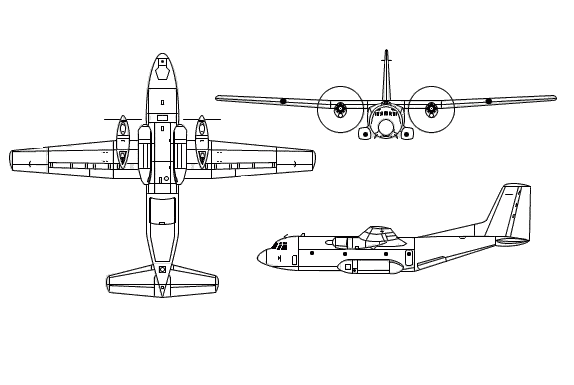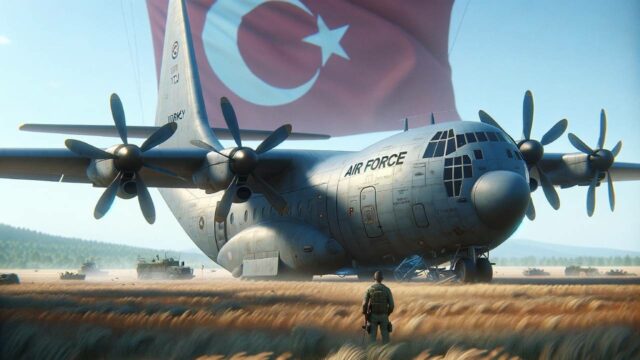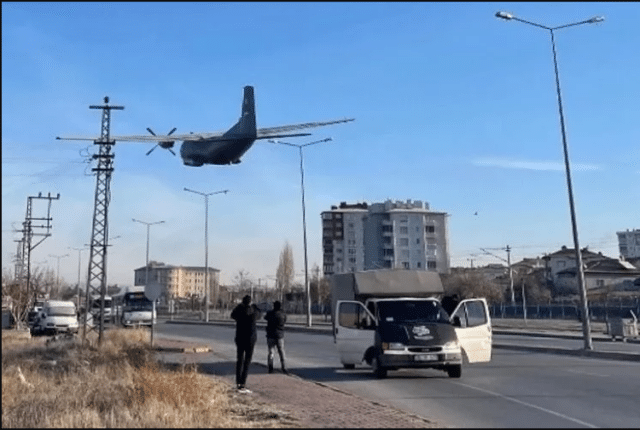Hard Landing of Turkey’s Vintage Transall C-160
On the 25th of January 2024, videos taken in the city of Kayseri showed a Turkish Air Force C-160 Transall aircraft flying dangerously low towards Kayseri Erkilet Airport in Turkey.
Ekibin eline sağlık, şehir içerisinde bir kazaya sebebiyet vermemişler. pic.twitter.com/JfOvk5HbsF
— TangoTangoLima (@Ttltlg) January 25, 2024
Kayseri Erkilet Airport is both a military air base and a public airport in the centre of Turkey. The airport has only one runway, and I couldn’t find any information as to how they share operations, but this incident was definitely on the military side of things.
The C-160 Transall was produced by Transport Allianz. Transport Allianz was a joint venture between France and Germany, formed in the late 1950s to design a modern transport aircraft to replace the Nord Noratlas. The C-160 was the result, despite repeated attempts by Lockheed to sell the C-130 Hercules to Germany. Over the production period from 1965 to 1985, 214 aircraft were produced. Over 2,000 modifications and upgrades were incorporated to the C-160 to extend its lifespan, including new features such as GPS, modern autopilots, kevlar armour and TCAS collision warning systems.
Over time, the German and French C-160s were replaced with Airbus A400Ms. Germany officially retired the fleet in 2021 and France in 2022, marking the end of an era. (The other major user, South Africa, retired their fleet in 1997).
The Turkish Air Force acquired twenty aircraft from Germany in 1971, which were then upgraded to a specific model for the Turkish Air Force, the C-160T. This fleet was based at Kayseri and flown by the 221 Squadron of the 12th Wing.
As of 2023, the Turkish Air Force was the only operator of the C-160 Transall, with only two C-160Ts remaining in service.
The C-160T registered as 69-036 was departing Kayseri Erkilet Air Base when the aircraft suffered a technical fault which has not yet been disclosed. The flight crew turned back for an emergency landing at the airport.
Today, crew of the last airworthy C-160D Transall transport aircraft of #Turkish Air Force encountered a technical failure after take off from Kayseri AB. They quickly returned to perform emergency landing. This is the world's last C-160 still in military use. It is used as… pic.twitter.com/f6S9i9EEwc
— Babak Taghvaee – The Crisis Watch (@BabakTaghvaee1) January 25, 2024
As the aircraft passes over head, you can see that the landing gear is not extended. Redditor Lanarsis points out that if you look at the props right at that moment, there’s quite a neat shot of the wind vortices.
The video clearly shows the flight crew attempting to keep the C-160T in the air for as long as possible. Shortly beyond the view of the video, the aircraft made it to the runway but then veered off after touchdown, coming to a halt on rough ground. The crew were able to escape the stricken aircraft without injury.
Although the Ministry of Defense initially reported that the aircraft had taken only minor damage, it has since been reported that the C-160T is beyond economic repair.
That leaves one Transall C-160T still flying, registered as 68-040.

Apparently, the Turkish Air Force have a second C-160T, registered as 68-023, which has been in storage for some years. It is not clear whether this second aircraft can be made airworthy. If not, the final C-160T may be retired as no reserve aircraft exists.
This is slightly off-subject and let me start by saying that I don’t consider myself anti-AI or particularly worried that AI is going to ruin aviation for me. However, I do think that public media companies that use AI-imagery for their editorial articles should be called out and shamed for being embarrassing.
For the avoidance of doubt, let’s take a look at this line drawing of a C-160 as shown on the Air Cavalry website.

Now take a look at this atrocity which appeared on a detailed news article about the crash.

This isn’t the journalist’s fault; I feel sure that the person who wrote the article also looked at the accompanying social media images that showed a twin-engine aircraft with a normal-sized cockpit and a sensible number of windows in a single row at the front.
However, whoever approved this photograph clearly has no idea and worse, couldn’t even be bothered to look at the actual photographs included in the same article.
Even ignoring the fact that it looks like the grotesque love child of an Airbus A400M and a C-160 which has swallowed a blimp, the very idea that an editor would use a fantastical image generator to accompany a news story just defies belief.

It’s disheartening enough that we’ve lost one of the last of these historic aircraft without having to put up with this nonsense. I wish I could sue for emotional distress.








Clearly a C130 Hercules in that other photo
OK, maybe its a C130 (but that cockpit! And the props look scary!) but that wasn’t as funny.
I have a screencap from 2012 of a BBC story about the United Nations Security Council… with the UNSC logo from the video game HALO as the only graphic.
Erwin Knoll’s law of media accuracy:
Everything you read in the newspapers is absolutely true except for the rare story of which you happen to have firsthand knowledge
I was explaining this concept to someone in regards to Google Translate (which is excellent! Until you see it translate a language pair that you know intimately) but I didn’t know there was a law that covered the phenomenon.
I once started collecting misidentified photographs in newpaper articles but then I wildly misidentified something and thought I should probably just leave it lie. :D
I believe it’s called the Gell-Mann Amnesia effect (coined by the late Michael Crichton).
“Briefly stated, the Gell-Mann Amnesia effect is as follows. You open the newspaper to an article on some subject you know well. In Murray’s (Gell-Mann) case, physics. In mine, show business. You read the article and see the journalist has absolutely no understanding of either the facts or the issues. Often, the article is so wrong it actually presents the story backward—reversing cause and effect. I call these the “wet streets cause rain” stories. Paper’s full of them.
In any case, you read with exasperation or amusement the multiple errors in a story, and then turn the page to national or international affairs, and read as if the rest of the newspaper was somehow more accurate about Palestine than the baloney you just read. You turn the page, and forget what you know.”
– Michael Crichton (1942-2008)
https://www.epsilontheory.com/gell-mann-amnesia/
Sylvia and other truth seekers, get used to this. Even ‘respected’ sources now turn too quickly to AI and agency stock image libraries having reduced or abandoned their own photographers and libraries. In defence that Herc does look like a poor artist’s impression for publicity material. More worrying is when AI creates an image, from a journalists text, itself ‘edited and improved’ by AI! Where is the truth?
Re the Transall. My school sat almost next to the BAe (ex Hawker-Siddeley, de Havilland) factory at Hatfield in the UK. Boring lessons were regularly interrupted by a West German Transall, RAF Argosy, de Havilland Dove, CAAC Trident, HS 125, DH Sea Vixen, BAe 146 and sometimes the Guppy or even the company Mosquito! passing the window gear down.
Please keep up your own quest, on our behalf, to present a considered and rounded analysis of this important subject.
I don’t know. I kind of like how the propeller blades don’t all have the same angle, how the bottom blades seem to droop a little on the far end (maybe they need to be watered?), how the blade count jumps between five and six, and how maybe there’s another propeller and engine hidden on the far wing.
I think there’s too much uniformity in the world. We need a little individuality. I wouldn’t fly on that thing, but we need it.
Boeing tried to break the monotony, introducing some variety in how they install their door plugs, but nobody thanked them. :-p
(There’s science fiction about sentient spacecraft, e.g. “The Ship Who Sang”, most individual.)